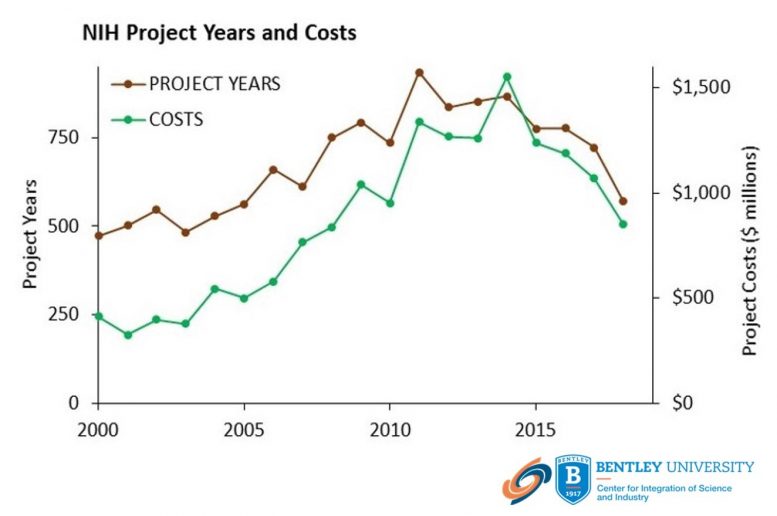
Annual project years and project costs associated with NIH-funded PMIDs 2000-2019. Credit: © Center for Integration of Science and Industry at Bentley University
Broad foundation of NIH-funded research for enabling technologies prior to pandemic provided a tool kit for rapid development of COVID vaccines.
The unprecedented development of COVID-19 vaccines less than a year after discovery of this virus was enabled by more than $17 billion of research on vaccine technologies funded by the NIH prior to the pandemic, according to new research from Bentley University’s Center for Integration of Science and Industry. The article, titled “NIH funding for vaccine readiness before the COVID-19 pandemic,” demonstrates the critical role this broad foundation of government-funded research plays in ensuring vaccine readiness.
The report, published today (April 22, 2021) in the journal Vaccine, examined the maturation of research and NIH funding for ten technologies that were applied in candidate COVID-19 vaccines as of July 2020. The maturation of these technologies was described in 51,530 published research papers from 2000-2019, of which 8,420 (16%) acknowledge NIH funding totaling $17.2 billion. Some of these technologies have been employed successfully in vaccines since the mid-20th century. Others, such as the viral vectors employed in the Johnson & Johnson and AstraZeneca vaccines, emerged from genetic engineering in the 1980s, and were found to be established prior to 2010. Still others, including the mRNA technologies employed by Pfizer/BioNTech and Moderna, only recently reached an established point.
“Rapid development of COVID vaccines was only possible because companies had access to a tool kit of established technologies,” said Dr. Fred Ledley, Director of the Center for Integration of Science and Industry. “Some of the most recent technologies, including mRNA and viral vectors, proved to be particularly suitable for COVID-19 and the timelines required to combat this pandemic. The substantial public sector investments over the past 20 years that went into the maturation of these technologies needs to be considered in the pricing of these products and their availability to the public.”
“This study also found surprisingly little NIH-funded, published research on vaccines for recognized pandemic threats, such as coronavirus, Zika, Ebola, or dengue virus,” said Dr. Anthony Kiszewski, lead author of the study and Associate Professor of Natural & Applied Science at Bentley University. “Mechanisms need to be developed for funding research on vaccine technologies that accelerate vaccine development against emergent threats and preempt future pandemics.”
Reference: “NIH funding for vaccine readiness before the COVID-19 pandemic” by Anthony E. Kiszewski, Ekaterina Galkina Cleary, Matthew J. Jackson and Fred D. Ledley, 22 April 2021, Vaccine.
DOI: 10.1016/j.vaccine.2021.03.022
Dr. Anthony Kiszewski was the lead author on this work along with Dr. Ekaterina Galkina Cleary, Dr. Matthew Jackson and Dr. Fred Ledley. This work was supported by a grant from the National Biomedical Research Foundation.









Be the first to comment on "Rapid COVID-19 Vaccine Development Built on Over $17 Billion in NIH Funding for Vaccine Technologies"